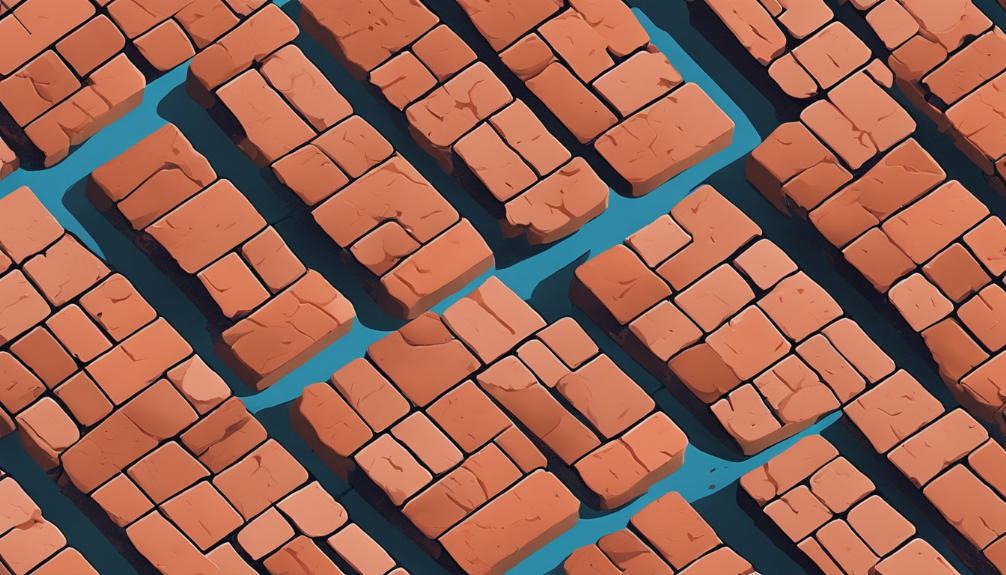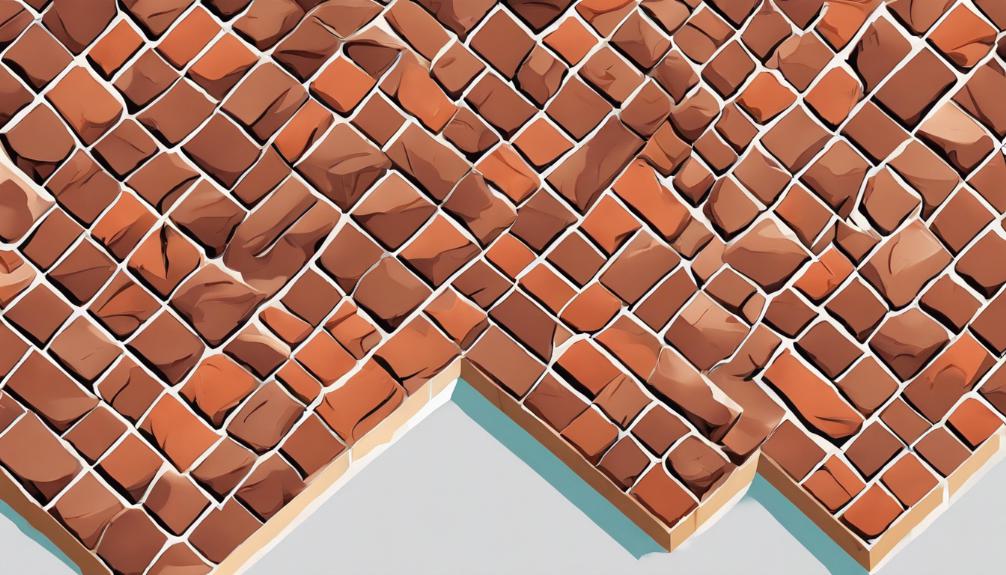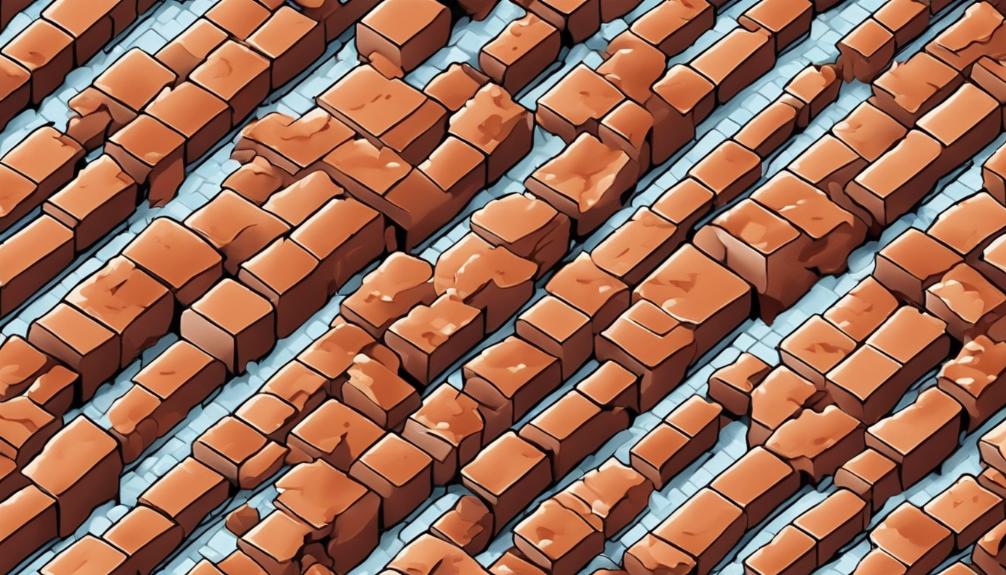Protect your bricks with sealing methods that keep water out and preserve their strength.
First, clean them with warm water and a gentle cleaner, then apply a sealant that stops moisture.
Seal old mortar to keep bricks strong. Before painting, prep the surface to block moisture for a durable finish.
What is brick waterproofing?
Brick waterproofing is the process of applying sealants to bricks to prevent water damage. It’s crucial because it stops mold growth and structural decay.
By using sealants like siloxane, it fills cracks and creates a water-repellent barrier. This treatment is essential to maintain brick integrity and appearance.
To keep the bricks protected, it’s important to regularly clean them and reapply sealant when necessary.
Why do you seal brick?
Sealing bricks is crucial to protect against water damage and maintain their structural integrity. Unsealed bricks can absorb water, leading to deterioration from moisture and freezing.
Applying a brick sealer creates a water-repellent coating, reducing damage risk and extending the bricks’ lifespan. Sealants use nano-technology to penetrate and fill internal cracks, offering superior protection. This process also supports moisture evaporation, preventing mold and frost damage.
Moreover, sealed bricks are less prone to cracking, minimizing water leakage risks into homes. Proper sealing is essential for brick longevity and soundness.
Methods and Techniques

When it comes to brick sealing, understanding how to clean and seal brick is essential. This process helps maintain the appearance and longevity of your brick surfaces.
Another important aspect is learning how to seal old brick mortar. Properly sealing old mortar can prevent water damage and extend the life of the brickwork.
Additionally, sealing brickwork before painting is crucial for achieving a smooth and long-lasting finish. This step ensures that the paint adheres properly and protects the bricks underneath.
These methods and techniques play a vital role in maintaining and enhancing the beauty and durability of your brick surfaces. Let’s explore how to execute these processes effectively.
How to clean and seal brick
To clean bricks, start by using warm water mixed with mild dish soap for basic dirt removal. For tougher stains, pressure wash with suitable cleaners or apply chemical cleaners designed for brick. For the most stubborn stains, use a bleach and water mix or a poultice. Always wear protective gear and rinse thoroughly after cleaning.
When sealing bricks, choose a brick sealant that prevents moisture penetration. Follow the manufacturer’s instructions carefully for applying the sealant. Use waterproof sealants for the best protection. Regular maintenance is crucial to keep the bricks sealed and prevent damage.
Seal old brick mortar
To seal old brick mortar, use a mortar rake to remove the old mortar. Clean the joints well for a strong new mortar bond.
Make a new mortar mix (sand, cement, water) and apply with a pointing trowel. Press firmly and smooth with a jointer tool for a uniform look.
Choose a sealant that suits your brick walls’ needs for protection and finish. This process preserves your brickwork’s integrity and appearance.
Seal brickwork before painting
To prepare brickwork for painting, seal the surface first. This prevents moisture from getting in and helps paint stick better.
Use a penetrating sealant on the bricks to fill any cracks and create a waterproof barrier. Sealing makes the paint last longer, protects against water damage, and ensures a smoother paint application. This leads to a more professional look.
Always follow the sealant manufacturer’s instructions for the best outcome.
Specific Applications

When considering specific applications for brick sealing, you should focus on:
- Interior brick waterproofing
- Sealing brick steps
- Applying floor brick sealer
- Using lacquer for bricks
These applications serve different purposes, from protecting interior surfaces to enhancing outdoor features like steps and floors. Understanding the specific needs of each area will help you choose the right sealant and guarantee long-lasting protection for your brick surfaces.
Interior brick waterproofing
For interior brick waterproofing, use sealants like Floorseal Interior Brick Sealer & Dustproofer. This approach prevents dust and stains, extending the lifespan of brick or stone surfaces. It improves the look by enhancing the color of the brickwork. Apply the sealant with a brush for easy and even coverage.
This method not only protects the bricks but also enhances their aesthetic appeal, making it a practical and visually pleasing solution for interior brick surfaces.
Seal brick steps
To seal brick steps effectively:
- Choose a penetrating sealant that’s made for outdoor use to protect against water damage.
- Ensure the steps are clean and dry before applying the sealant for strong adhesion.
- Apply the sealant evenly, making sure to cover the entire surface of the steps.
- Inspect and maintain the sealed steps regularly to ensure they remain durable and protected.
Floor brick sealer
Use Floorseal Interior Brick Sealer & Dustproofer on both old and new brickwork and masonry. It stops stains and prevents dusting on sandblasted and soft surfaces. Key points:
- Stain Protection: This sealer gives your brick floor long-lasting protection against stains.
- Looks Better: It provides a clean, matt look that brings out the brick’s natural beauty.
- Easy to Use: You can cover 8m² per liter, making it easy and safe to apply, even near fireplaces.
Lacquer for bricks
Enhance your sealed floor bricks with a clear lacquer specifically made for bricks. This lacquer acts as a water repellent and protects against moisture, UV rays, and stains, extending the bricks’ lifespan.
It offers a glossy or matte finish and is suitable for both interior and exterior surfaces. Choose from water-based or solvent-based options for flexibility in application and finish, ensuring your bricks stay protected and look good longer.
Frequently Asked Questions
What Is the Best Way to Seal Brickwork?
For the best way to seal brickwork, consider factors like protection level and finish. Choose between penetrating or film-forming sealants based on your needs. Follow manufacturer instructions carefully for effective application and opt for waterproof sealants for long-lasting results.
What Is the Best Sealer for Brick?
For the best sealer for brick, consider factors like protection level and finish. Choose waterproof sealants for long-term defense. Follow manufacturer instructions for proper application. Regular maintenance is essential for preserving sealed bricks and preventing damage.
Is Sealing Bricks a Good Idea?
Sealing bricks is a great idea to guarantee water damage, mold growth, and discoloration. It improves durability and aesthetics. Follow proper steps for cleaning, inspecting, and applying sealant. Regular maintenance secures long-term protection and reduces maintenance needs.
How Do You Waterproof Old Brickwork?
To waterproof old brickwork effectively, assess brick condition, clean thoroughly, seal cracks with penetrating sealant, and follow manufacturer instructions. Regular maintenance, like reapplication of sealant, is crucial for long-term protection against moisture and damage.
